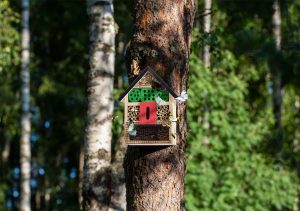The Bee Hummingbird: A Jewel of the Cuban Rainforest
Imagine a world of birds where all the bird species are so small and swift, but you don’t know which bird is the smallest one among the same species of birds.
Don’t worry. I’m here to help you to identify the smallest hummingbird species in the world.
So, don’t waste your time and let’s get started to learn more about this hummingbird
bird species.
Meet Tiny Hummingbird
The BEE HUMMINGBIRD is the smallest and tiniest hummingbird species in the world. It is also currently the smallest bird in the world.
It is only about 2 inches long and weighs less than a penny! or less than 2 grams.
You can easily find this bird in Cuba. It has a green back and a white belly. The male has a red throat.
The Tiny Hummingbird’s Diet
The tiny Bee Hummingbird feeds on nectar and insects. It hovers in front of flowers and sucks the nectar with its long, thin bill. It also eats small insects, like gnats and mosquitoes.
They mainly eat something called nectar. Nectar is like the sweet water inside flowers. Hummingbirds use their long beaks to drink nectar from flowers. Therefore, we can prepare a suitable for menu for these cute birds in our bird feeders.

Tiny Hummingbird’s Habitat and Distribution
The Bee Hummingbird is the smallest bird in the world. It lives only in Cuba and the Isla de la Juventud. These places are like home to them. Bee Hummingbirds like to live in forests, gardens, and along the coast.
They really like flowers because they drink something called nectar from them. The flowers need the Bee Hummingbirds too, because when they fly from one flower to another, they help the flowers make babies.
But, there’s a problem. Sometimes people cut down trees and do things that hurt the Bee Hummingbird’s home. We need to be careful and take actions to help them, such as installing bird feeders , bird houses, bird bath and so on.

The Tiny Hummingbird’s Nest
When it the time to build a nest, the female hummingbird takes on the role of decorator. Bee Hummingbirds make their nest out of leaves, moss, and spider webs. It is usually built on a branch or in a hollow tree. This tiny Bee Hummingbird lays 2 eggs in its tiny nest.
Love Story and Nesting
Love is in the air, and high up in the sky! To win the heart of a mate, male hummingbirds put on quite a show. The tiny male hummingbird courts the female by flying around her and showing off his red throat. Once a mate is found, both the male and female build a nest together and take turns keeping the precious eggs warm. The eggs hatch in about 2 weeks, and the young hummingbirds fledge in about 3 weeks.
Threats to The Tiny Hummingbird
Like the largest hummingbird, the Bee Hummingbird’s main threats are habitat loss and climate change. We all know that deforestation and development cause are the main causes of habitat loss. Climate change also makes it harder for the Bee Hummingbird to find food and water. Therefore, providing enough bird feeders is urgent and necessary for Bee Hummingbirds.

Conservation Efforts
Humans are like guardian angels for hummingbirds. Planting flowers that are rich in nectar and creating safe spaces for them can greatly help these enchanting birds. By looking out for them, we’ll ensure that their natural playground remains vibrant and secure.
How to Help the Tiny Hummingbird
There are many things you can do to help the tiny hummingbird. You can plant more flowers in your garden, especially native flowers that attract hummingbirds. You can offer multiple bird feeders in winter when food is scarce. You can also avoid using pesticides in your garden, which can harm hummingbirds. And you can support organizations that work to protect hummingbird habitat.

Final Thoughts
In summary, the tiny hummingbird is truly a fascinating wonder of nature. Their bright feathers, incredible agility, and boundless energy capture our attention and curiosity. In this blog post, we’ve explored these amazing little creatures, learning about their unique characteristics and how they help pollinate our world. So, the next time you see a hummingbird fly by, remember that even a small creature can have a big impact. In this way, we’re all connected in the delicate balance of nature, and anyone, even a young child, can appreciate and understand the wonders around us.













Post Comment